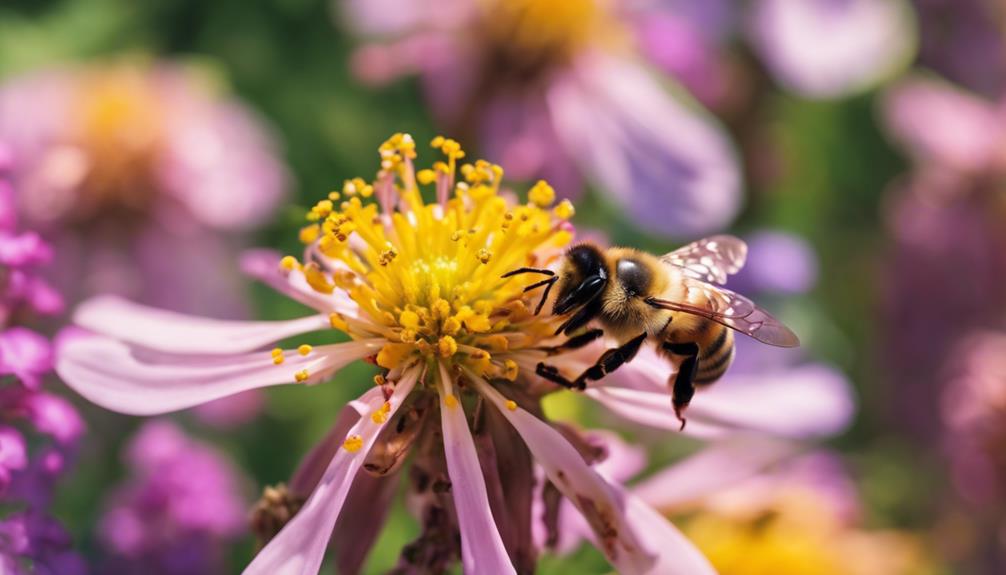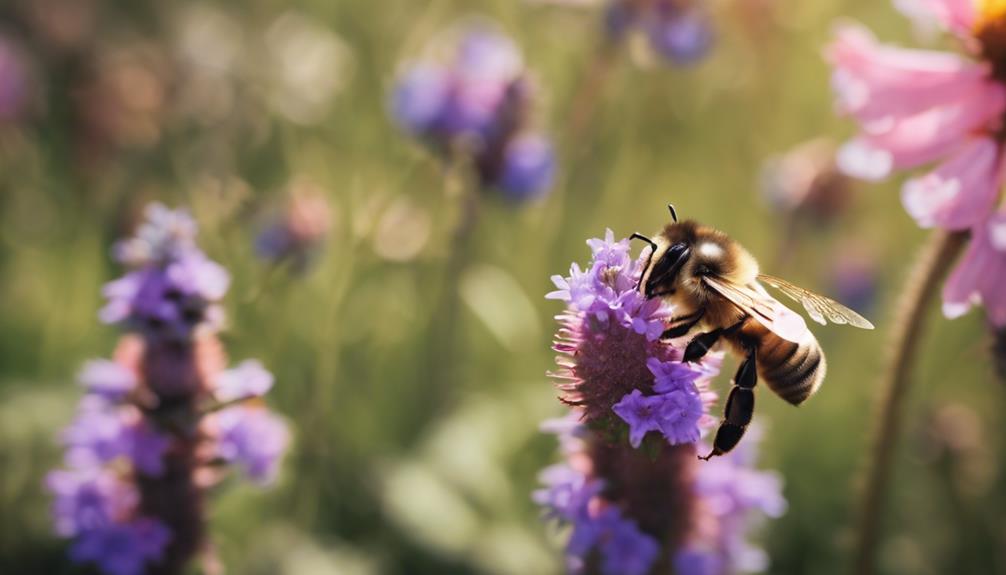In the bustling hive, worker bees take on a multitude of critical roles essential for the hive’s functioning. From cleaning cells and feeding the young to producing honeycombs and defending the colony, these bees wear many hats. Particularly crucial is their foraging prowess, where they tirelessly collect nectar and pollen for the colony’s sustenance. Their intricate communication through dances guides others to rich resources, showcasing their teamwork in action. The worker bees’ diligent efforts not only maintain hive health but also contribute to broader ecosystem well-being. Indeed, the multifaceted contributions of these busy bees guarantee the hive’s prosperity and survival.
Curious about how these tiny marvels keep the hive buzzing with activity?
Main Points
- Worker bees clean cells, feed brood, produce wax, protect the hive, and forage for resources.
- They undergo metamorphosis stages and contribute to hive tasks based on their abilities.
- Worker bees communicate through dances to convey food source locations.
- Their contributions include collecting nutrients, maintaining hive health, and ensuring survival.
- Worker bees play a vital role in sustaining the hive, supporting growth, and maintaining ecosystem health.
Worker Bee Tasks and Responsibilities
As worker bees progress through their life stages, they undertake a series of essential tasks and responsibilities within the hive. Starting as housekeeping bees, we diligently clean cells for new eggs, ensuring hive cleanliness for our colony’s well-being.
Evolving into nurse bees, we delicately feed brood cells and support the queen in her egg-laying duties. Becoming wax masons, we skillfully produce wax for constructing honeycombs and maintaining the hive structure.
As we mature, we take on the pivotal role of guard bees, fiercely protecting the hive from any potential threats or intruders. Finally, embracing our role as foragers, we set out on important missions to collect nectar, pollen, propolis, and water, gathering essential resources to sustain our beloved colony.
Worker Bee Life Cycle Stages
During their life cycle, worker bees undergo metamorphosis stages including egg, larva, pupa, and adult, with the entire process lasting approximately 21 days.
The journey begins as tiny eggs laid by the queen in the honeycomb cells. These eggs hatch into larvae, resembling little white worms, and are diligently cared for by nurse bees who feed them royal jelly.
As the larvae grow, they enter the pupa stage, where they undergo remarkable transformations inside capped cells. Finally, after a period of development, the adult worker bees emerge to take on various tasks within the hive.
It’s fascinating how each stage contributes to the development of these essential workers, shaping their abilities and roles in the colony.
Importance of Foraging for Worker Bees

As worker bees, we grasp the vital role of foraging in maintaining our hive. Our foraging strategies, nectar collection process, and pollen-gathering techniques are finely tuned to guarantee the colony’s survival.
Through efficient foraging, we collect the essential resources needed to support our queen and fellow bees.
Foraging Strategies of Worker Bees
Efficient foraging strategies are essential for worker bees to collect important resources and maintain the productivity of the hive. Here are three key aspects of how worker bees optimize their foraging efforts:
- Communication Through Dances: Worker bees perform intricate dances to convey precise information about the locations of rich nectar and pollen sources. These dance moves are like a secret code that guides others to the valuable caches of resources.
- Navigating Resource Locations: Worker bees have a remarkable ability to memorize and navigate complex landscapes to efficiently gather nectar and pollen. They zip through fields and forests, ensuring the hive is well-stocked with necessary supplies.
- Contribution to Ecosystem Health: By engaging in pollination while foraging, worker bees play an important role in maintaining the health and biodiversity of ecosystems. Their foraging efforts benefit not only the hive but also the surrounding environment.
Nectar Collection Process
Worker bees diligently gather nectar using their specialized honey stomach to sustain the hive’s nutritional requirements.
Nectar is an important resource for our colony, essential for producing honey and meeting our nutritional needs.
Our foraging behavior revolves around collecting nectar from flowers, a task essential for the hive’s survival.
The honey stomach, distinct from our digestive system, serves as a specialized organ for nectar storage.
Through efficient nectar utilization, we contribute to the overall well-being of the colony by ensuring a steady supply of this valuable resource.
Our role in nectar collection not only supports the immediate needs of the hive but also plays a significant part in the long-term sustainability and success of our community.
Pollen-Gathering Techniques
Gathering pollen with specialized structures called pollen baskets, worker bees play an essential role in providing necessary protein for the colony’s growth and development. When collecting pollen, worker bees exhibit fascinating techniques that guarantee the colony’s well-being:
- Efficient Pollen Collection: Worker bees carefully pack pollen onto their hind legs using specially designed baskets, maximizing the amount gathered during each foraging trip.
- Promoting Biodiversity: Through their foraging behavior, worker bees aid in the pollination of flowering plants, contributing to the ecosystem’s richness and diversity.
- Storage for Future Use: Bees meticulously store the collected pollen near the brood area, combining it with honey and wax for long-term sustenance and growth of the colony.
These techniques showcase the meticulous and vital role of worker bees in sustaining their community’s health and prosperity.
Communication Among Worker Bees

Communication plays a pivotal role among worker bees in the hive, especially through the intricate waggle dance. When a worker bee discovers a bountiful food source, it returns to the hive bursting with excitement. Through its dance, it conveys the direction and distance of the food, allowing fellow workers to swiftly decode the information and head out to collect resources.
It’s fascinating how these bees communicate effectively without saying a word! This seamless exchange of information is vital in coordinating foraging activities, ensuring the hive’s survival. The accuracy of the waggle dance is like a well-choreographed ballet, optimizing the collection of essential resources. These tiny dancers truly showcase the power of teamwork and communication in sustaining the hive.
Worker Bee Contribution to Hive Health
In understanding the holistic role of a worker bee within the hive, it becomes evident that their contributions to hive health extend beyond mere foraging activities. Here are three essential ways in which worker bees play a vital part in maintaining hive health:
- Collect Pollen: Worker bees diligently gather pollen, nectar, water, and propolis to provide essential nutrients and resources for the hive.
- Hive Maintenance: They take care of tasks like cleaning cells, feeding larvae, and regulating hive temperature, ensuring a clean and healthy environment for the colony.
- Foraging and Nursing: Through specialized roles in foraging for food and caring for the young, worker bees contribute to the overall well-being and productivity of the hive. Their dedicated efforts are instrumental in sustaining the hive and supporting its growth.
Worker Bee Defense Mechanisms

Worker bees utilize their barbed stingers as a crucial defense mechanism to protect the hive from threats. When a bee stings, not only does it inject venom that can cause discomfort, but it also releases alarm pheromones to alert its fellow workers of danger. This coordinated effort helps the hive respond quickly to potential risks.
However, there’s a bittersweet aspect to this defense mechanism; once a worker bee stings, it sacrifices its life. The act of stinging causes the stinger to detach from the bee’s body, along with essential organs, ultimately leading to the bee’s demise. Despite the ultimate price some worker bees pay, their defensive mechanisms play a critical role in safeguarding the hive and ensuring the collective survival of the colony.
Worker Bee Winter Survival Tactics
During the harsh winter months, worker bees employ various survival tactics to endure the cold and ensure the hive’s continued existence.
- Hive Clusters: Worker bees form tight clusters within the hive, huddling together to generate and maintain heat.
- Wing Muscles: By vibrating their wing muscles, worker bees help regulate the cluster temperature, ensuring the queen stays warm and protected.
- Fat Bodies and Collective Body Heat: Winter bees have specialized fat bodies that sustain them through reduced foraging opportunities. They rely on their collective body heat, not hibernation, to brave the cold temperatures and survive as a cohesive unit.
These swarm activities and cluster formations are essential for their survival during the winter chill.
Worker Bee Role in Swarming

When it pertains to swarming, worker bees are the unsung heroes of the hive, taking control of vital tasks to guarantee the colony’s survival.
Their responsibilities include hurrying the queen out of the hive, relocating to a new home, and preparing for the establishment of a new colony.
Worker bees showcase their remarkable coordination and dedication during swarming, forming a protective cluster around the queen to facilitate her safe transport to the new location.
Swarming Behavior Explanation
Swarming behavior in bee colonies involves a crucial process of reproduction and expansion, where worker bees diligently work together to protect the queen and relocate the colony to a new home. Here’s a closer look at how this fascinating process unfolds:
- Worker bees engage in swarm activities by rushing the queen out and relocating the colony to a new home.
- They generate heat during swarming by vibrating their wing muscles to protect the queen and brood.
- Swarm clusters are formed by worker bees to protect the queen and maintain warmth during the relocation process.
Through their coordinated efforts, worker bees play an essential role in ensuring the success of the swarming behavior, showcasing their dedication to the well-being of the colony.
Worker Bee Responsibilities
As worker bees engage in swarm activities, our responsibilities encompass locating a new hive and safeguarding the queen throughout the swarming process. During swarming, we rush the queen out of the hive, forming a protective cluster around her to establish a new colony. Our coordination and cooperation are essential for the success of this venture.
We exhibit unique behaviors like fanning pheromones to guide the swarm to a suitable nesting site. Protecting the queen is pivotal as she’s the heart of the hive, ensuring hive unity and strength. Working together, we guarantee the queen’s safety and the establishment of a thriving new colony.
Our dedication to these tasks highlights the intricate and critical role worker bees play in the fascinating phenomenon of swarming.
Worker Bee Impact on Colony Sustainability
In ensuring hive sustainability, worker bees actively contribute to the colony’s overall health and longevity through their various tasks and important role in pollination. Here’s how they impact colony sustainability:
- Foraging: Worker bees tirelessly collect pollen and nectar, ensuring a stable food supply for the hive.
- Nursing Larvae: They attentively care for the young bees, ensuring the growth and development of the next generation.
- Division of Labor: Through a well-organized division of labor, worker bees efficiently manage hive tasks, contributing to the productive hive environment.
These efforts by worker bees are essential for maintaining a thriving colony, supporting not just their own kind but also the broader ecosystem through essential pollination activities.

Hello! My name is Noel Calvin. I graduated from UCLA and now work as a writer at Launch Ninjas. I write blog posts that inspire and guide our readers in their entrepreneurial pursuits. I live in Pleasantville, NJ, with a peaceful yet lively atmosphere that inspires me.
Writing stories is more than just a job for me. It allows me to share my observations and satisfy my curiosity about the world. I combine my analytical skills with creative enthusiasm to delve into technology trends and startup stories. But my life isn’t limited to screens and keyboards. I value loyalty, passion, and a touch of old-fashioned charm, which I infuse into every narrative I create.
I love spending time in my garage, jamming with my band when I’m not writing. Playing the guitar and singing bring me immense joy. I also enjoy capturing ordinary and extraordinary moments through my camera lens and exploring new culinary adventures that excite my taste buds. I’m always seeking new experiences.
My family is very important to me. Joyful Sunday brunches filled with laughter and intense board game nights keep me grounded, reminding me of life’s simple pleasures.
In my world, every moment is an opportunity for discovery. Every discovery is a story worth sharing, whether a heartfelt moment at home or the pulse of technological innovations. Join me as I navigate through life, one blog post, one guitar strum, and one heartwarming family dinner at a time.


